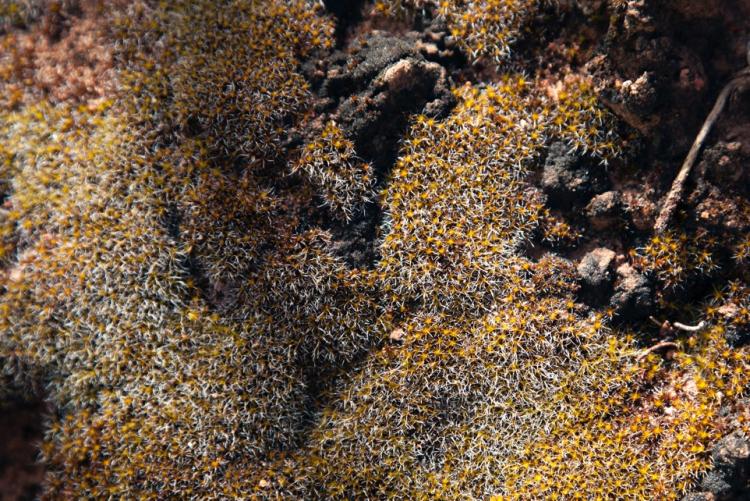Microscopic structures on moss leaves collect water from humid air
Four naturalists hiked in the Maze in Canyonlands National Park, taking in the magnificent geology, novel biology and stunning landscape. Scott Ferrenberg, who received his PhD at the University of Colorado Boulder and is now a postdoctoral fellow at the Southwest Biological Science Center in Moab, stopped us to draw our attention to a drab brown moss.
Desert moss, Syntrichia caninervis, covered much of the soil around us. It is a major component of desert crusts that stabilize soils in drylands, and is widespread in western North America, Europe and Asia.
Plants in arid lands have a wide diversity of adaptations to collect and preserve water, including tiny and waxy leaves to minimize water loss and shed rainwater to roots, extensive root systems to collect water and root structures to store water. But this moss lacks roots and appeared brown and desiccated, so why is it so widespread and common on the Colorado Plateau and in the Great Basin, Mojave, Sonoran and Chihuahuan Deserts?

This moss, widespread in arid lands and an important component of desert crusts, collects water from humid air with microscopic grooves and barbs on its awns, the white hair-like projections from the leaves
Microstructures are the surface architecture too small to be seen by the naked eye, but nevertheless an important component of adaptations. It enables insects and some lizards to walk on vertical panes of glass, excludes water from the feet and legs of water striders so they can walk on water, and it can enhance both the condensation of water, or nucleation, from humid air and the extraction of water from fog.
The smallest microstructures are nano-grooves, tiny trenches that are just the right depth and angle to allow humid air to form liquid water and accumulate to form dewdrops. Micro-grooves are larger trenches just the right size and shape to coax the microscopic droplets from fog to attach and accumulate to larger drops.
Small barbs on the awns are cone-shaped, or conical, with the end of the barb pointing toward the free end of the awn, and barbs serve as collection depots and pumps. When droplets from nano- and micro-grooves form on the surface of a barb, the conical shape of the barb causes droplets to have elliptical shapes, more tightly rounded on the tip side, more gently rounded on the side toward the base. The asymmetrical shape of the water droplet on a conical surface induces differences in internal pressure across the droplet, with lower pressure inside the more gently curved surface. Technically, this process is called a Laplacian pressure difference, but practically, it drives the water droplet to move toward the base of the barb, even if that direction is uphill. Thus, the water moves toward the base of the barbs and the awn, where it moves onto the leaf to be absorbed.
Moss macrostructures also help collect water. Flexible leaves and awns enhance water collection during rain by forming a soft, pliable surface that minimizes the splash of each droplet, conserving water to be pumped toward the leaf tip.
When a weather front moves across the desert, replacing dry air with humid, water nucleation and pumping are so efficient that brown, dreary mosses turn green within a few minutes. Water is scoured from the air, accumulated, and pumped onto the surface of the leaves, without any caloric cost to the moss. It is all a matter of physics.
See the process for yourself—watch this short video showing awns collecting and pumping water:
[video:https://www.youtube.com/watch?v=wwEE4fqYq7A]

